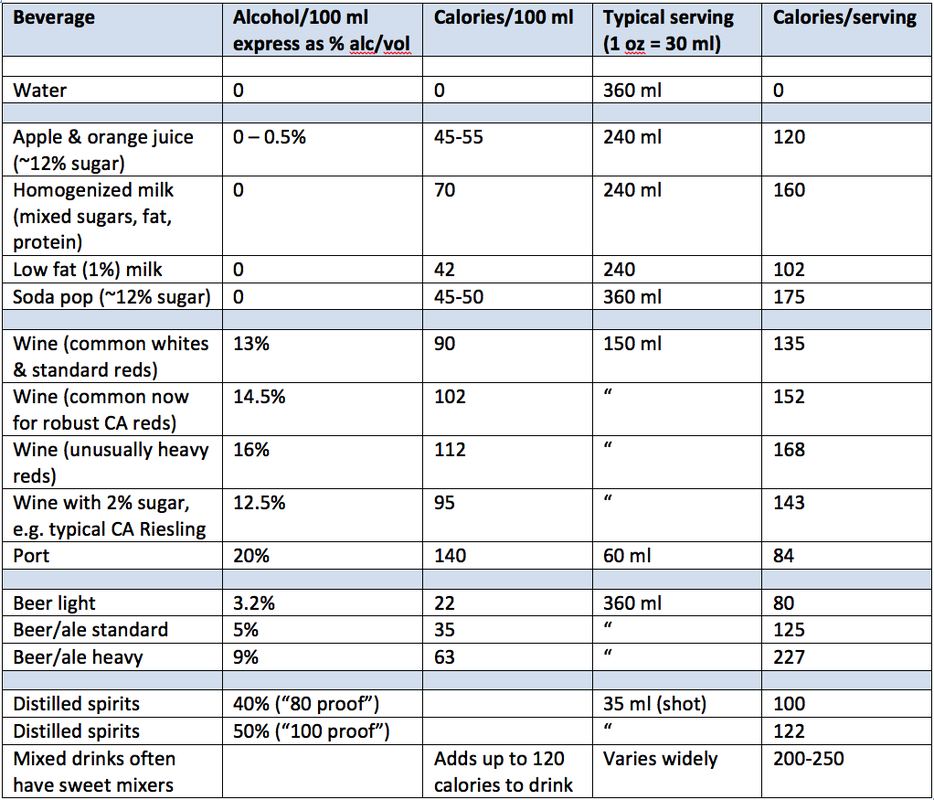Calories in Wine (May 2015)
|

Wine won’t make you fat, but it certainly does contain calories. So do most things we drink other than beautiful, clear water. How many calories is that, and should that knowledge influence our behavior? Curious people want to know.
For starters, the answer to that question depends upon the amount of alcohol in the wine, the size of the serving, and the number of “helpings.” Perhaps equally important, the caloric impact depends a great deal upon the circumstances in which you serve it…the accompanying food and social setting. I’ll address that more complex question towards the end.
But first, the simple calories. Alcohol has 7 calories per gram; fat 9; sugar and protein 4. Knowing the alcohol concentration of the beverage and the volume, it’s rather easy to calculate the calorie content of a standard serving. You’ll find below a table which gives calorie content for wines of a typical commercial range of styles, along with comparisons to common beverages such as beer, spirits, soft drinks, fruit juice, and cows’ milk.
To condense the message: most 5 oz standard servings of wine carry about 150 calories, about the same range as a bottle of beer, a shot of distilled spirits, or a glass of orange juice. An entire bottle of wine will hold 700-800 calories, still well shy of just one “modern” hamburger, but nevertheless a hefty percentage of the 2500 calories most healthy people should consume in a day.
We’ve grown accustomed to seeing nutrition content labels on most of our packaged food. A few folks want to see those on wine, too. It’s part of the politics of our day. However, just because the labeling is either a dorky idea or a thinly disguised punitive counterpunch from the prohibitionists, it doesn’t mean consumers shouldn’t have a ready reference to the information. You’ll find it right here!
We invite you to check out the table below!
The bottom line for any calorie-containing food or beverage, of course, is arithmetic. It’s not rocket science. It’s always possible to simply serve less and still enjoy the marvels of great craftsmanship.
For starters, the answer to that question depends upon the amount of alcohol in the wine, the size of the serving, and the number of “helpings.” Perhaps equally important, the caloric impact depends a great deal upon the circumstances in which you serve it…the accompanying food and social setting. I’ll address that more complex question towards the end.
But first, the simple calories. Alcohol has 7 calories per gram; fat 9; sugar and protein 4. Knowing the alcohol concentration of the beverage and the volume, it’s rather easy to calculate the calorie content of a standard serving. You’ll find below a table which gives calorie content for wines of a typical commercial range of styles, along with comparisons to common beverages such as beer, spirits, soft drinks, fruit juice, and cows’ milk.
To condense the message: most 5 oz standard servings of wine carry about 150 calories, about the same range as a bottle of beer, a shot of distilled spirits, or a glass of orange juice. An entire bottle of wine will hold 700-800 calories, still well shy of just one “modern” hamburger, but nevertheless a hefty percentage of the 2500 calories most healthy people should consume in a day.
We’ve grown accustomed to seeing nutrition content labels on most of our packaged food. A few folks want to see those on wine, too. It’s part of the politics of our day. However, just because the labeling is either a dorky idea or a thinly disguised punitive counterpunch from the prohibitionists, it doesn’t mean consumers shouldn’t have a ready reference to the information. You’ll find it right here!
We invite you to check out the table below!
The bottom line for any calorie-containing food or beverage, of course, is arithmetic. It’s not rocket science. It’s always possible to simply serve less and still enjoy the marvels of great craftsmanship.
- You don’t have to eat a whole movie theater sized Milky Way or a crunch up the entire bag of seductive Maui Sweet Onion kettle cooked potato chips. Stop halfway…or never open the package until you are sure you can share it.
- If you love the taste of fresh, whole milk, but don’t want the fat calories and don’t care for the texture of skim, pour a smaller glass.
- If a 5 ounces glass of wine has more calories than fit in your program, well, have a glass with 3 or 4 ounces. Savor it, and skip the second serving.
The environmental setting also changes the way we look at calories from wine. Typically, wine is consumed slowly, among company in a socially engaged setting, along with a meal which unfolds over time. That’s really different from a noisy bar or a 3 hour football game.
These seem to be useful considerations when we look at wine, food, and human nature:
|
|
a. In contrast, a “fast” gulping of a high fat meal along with a chuggly
guzzle of super-sized flagon of sugary soda opens the door to
considerable metabolic mayhem. The blood sugar
leaps up with a hydrant blast of rapidly absorbed sugar, followed by a
surge in insulin…right in time to greet the greasy tide of fat globules
looking for new homes. You’ll wear those calories.
|
|
5. Anything that’s harmonious in moderation can be problematic in excess…true for wine just like everything else.
6. If you want to discipline yourself for both the calorie and alcohol content of wine, here’s an idea:
Wells Shoemaker MD, Winemaker May 2015 |
Calories for Standard Servings of Common Beverages
1. Soft drinks and juices vary in sugar content by manufacturers’ formulae. Figures below are representative, but may not be precise.
2. Figures for wine, beer, and spirits assume no sugar content (“dry”). Wines with residual sweetness (typically glucose 1 – 3 grams/100 ml) will have an additional 6 -18 calories per serving. One example is included in the chart for “ball park” accuracy.
3. Calorie content of drink components:
1. Soft drinks and juices vary in sugar content by manufacturers’ formulae. Figures below are representative, but may not be precise.
2. Figures for wine, beer, and spirits assume no sugar content (“dry”). Wines with residual sweetness (typically glucose 1 – 3 grams/100 ml) will have an additional 6 -18 calories per serving. One example is included in the chart for “ball park” accuracy.
3. Calorie content of drink components:
|
a. Sugar (and other carbohydrates):
b. Protein: c. Fat: d. Alcohol: |
4 calories/gram
4 calories/gram 9 calories/gram 7 calories/gram |

